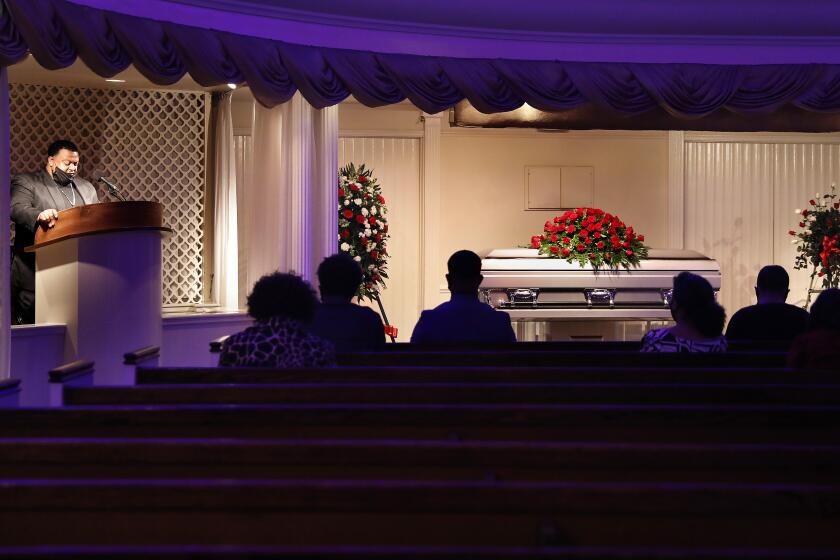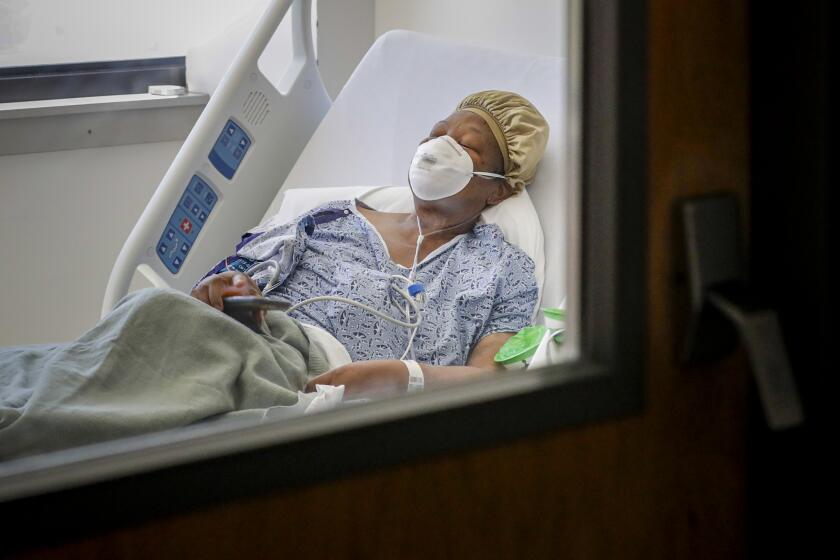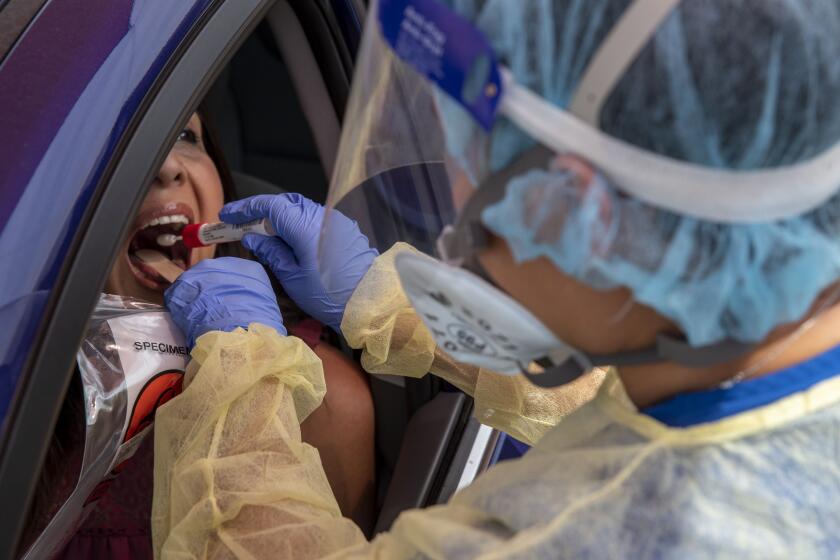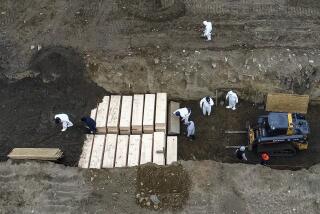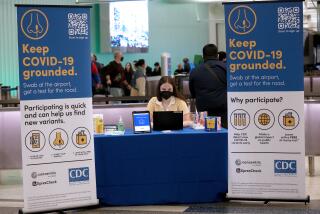California Latino, Black residents hit even harder by coronavirus as white people see less danger
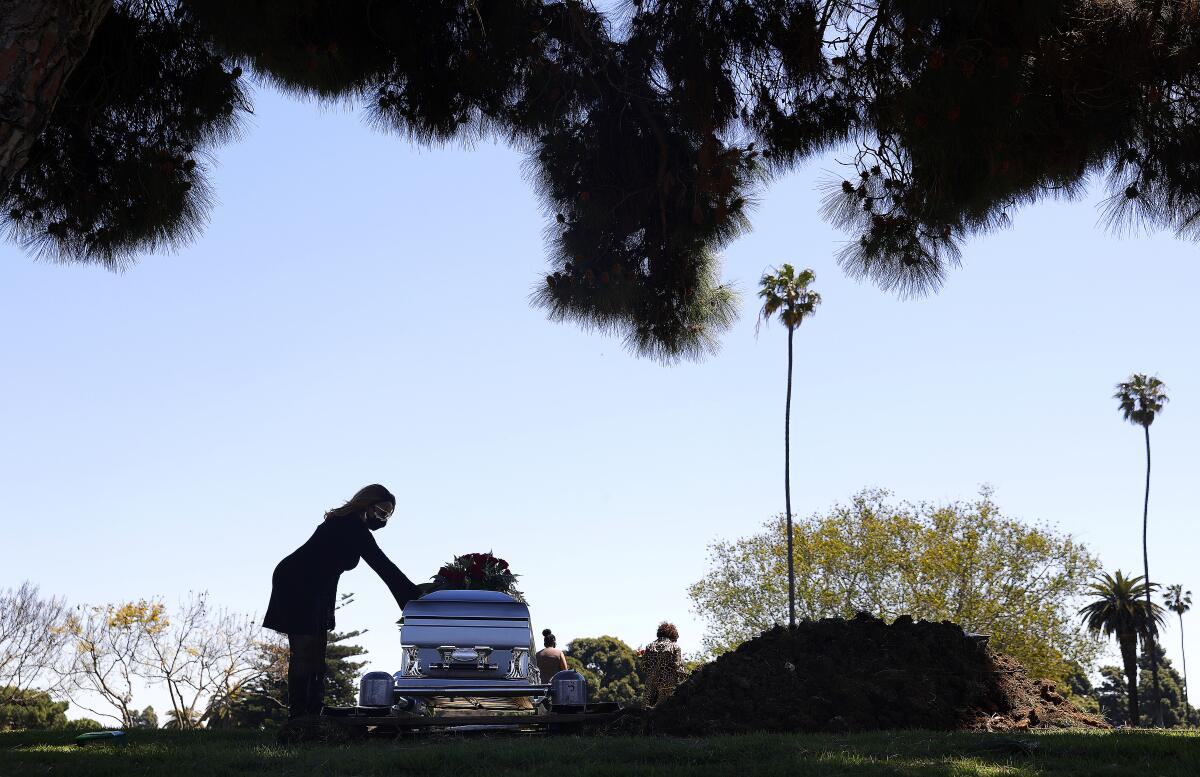
- Share via
SAN FRANCISCO — With coronavirus cases surging, the toll on Latino and Black Californians keeps getting worse.
The two groups now have double the mortality rate from the virus in Los Angeles County than white residents, the latest troubling sign of the deep health inequity that has come with COVID-19.
Of every 100,000 Latino residents of L.A. County, 38 have died from COVID-19. It’s the first time the Latino coronavirus death rate has surpassed that of Black residents in L.A. County, which also continues to be disproportionately high. Of every 100,000 Black residents, 37 have died, according to data released by the county Thursday.
Among every 100,000 Asian American residents, 25 have died.
White residents had the lowest mortality number of any race or ethnicity. For every 100,000 white L.A. County residents, 19 have died.
People of color have been disproportionately affected by the coronavirus in various communities across California, as have been areas with higher levels of poverty. In L.A. County, people living in areas with the highest rates of poverty have a mortality rate quadruple that of residents living in the wealthiest neighborhoods.
Experts have said that Black and Latino residents disproportionately work in jobs where they must leave home to get paid as essential front-line workers. It’s the highest-paid Americans who have the greatest ability to work from home, according to a report by the Pew Research Center.
“It’s a luxury to shelter in place,” Dr. Kirsten Bibbins-Domingo, chair of UC San Francisco’s Department of Epidemiology and Biostatistics, said in an interview.
Blacks, Latinos and Pacific Islanders are twice as likely to die as whites in Los Angeles County from the coronavirus, according to new data.
Bibbins-Domingo said an estimated 1 in 1,500 Black people nationwide have died from COVID-19 so far in the pandemic. Black people, she said, are more likely to be exposed to the virus.
“The causes here are not genetic,” Bibbins-Domingo said a recent campus town hall. “They are overrepresented in the low-wage essential workforce, in healthcare, in food production and distribution, in other types of occupations that have been essential in keeping our streets and hospitals clean and keeping our environment safe.”
Racism has a pernicious effect on health that can begin in childhood and leave people of color less healthy than their white counterparts, experts say, leaving them more susceptible to chronic illness, and as a result, death in a pandemic.
“Racism operates as a chronic stress that can lead to toxic stress on a biological level,” affecting the brain, said Dr. Dayna Long, pediatrician and medical director of the Department for Community Health and Engagement at the UCSF Benioff Children’s Hospital Oakland.
The more doses you get of chronic stress and adversity, the worse the impact is on your physical and mental health — and it’s cumulative, Long said. “It can lead to effects that affect our hearts, our minds and our bodies. ... Ultimately, this exposure to racism can cause poor health outcomes that are extending across the lifespan,” and can affect things such as birth weight and rates of upper respiratory tract infection and asthma.
Racism contributes to health disparities that can persist independent of wealth or education. For instance, Long, as a highly educated Black woman, has statistically a much higher chance of giving birth to a premature baby than an equally educated white woman. And a lot of it, she said, “is because of chronic stress and fatigue secondary to issues like discrimination.”
Health disparities can also pass over the generations. Recent research in genetics reveals that high levels of stress and adversity can lead to alterations in the way that the body reads its DNA and can lead to higher rates of diabetes, obesity, cancer or lung disease, Long said.
Long said her research has found that more than 20% of mostly Black and Latino children in Oakland up to their 12th birthday have experienced discrimination.
And more than half have endured at least four forms of “adverse childhood experiences,” which traditionally have been defined as experiences such as abuse and neglect. In recent years, other factors, such as food and housing insecurity, community violence and discrimination have been found to also contribute to adverse childhood experiences, and can leave those encountering them to be more vulnerable in a pandemic.
Adverse childhood experiences are associated with the most common and serious chronic health conditions, and affect all communities, but do so disproportionately among communities of color.
“The more adversity that you have, the higher your rate of toxic stress, and that can lead to poor health outcomes,” Long said.
Structural racism that contributes to reduced access to healthcare in communities of color worsens the situation. “We have a lot of reports in many cities of people not being able to get testing or being turned away with symptoms,” Bibbins-Domingo said.
Underlying conditions, such as high blood pressure, diabetes and asthma, are more common in Black and Latino communities than white communities — disparities that persist even among people with similar higher income levels, Bibbins-Domingo said.
Residents of nursing homes that have a higher proportion of Black or Latino residents are more than twice as likely to have outbreaks of coronavirus compared with other nursing homes where residents are predominantly white, Bibbins-Domingo said, citing a recent analysis.
Here’s what we can do about COVID-19’s racial inequality.
A Los Angeles Times analysis published in May found that South and Central Los Angeles and the Eastside have seen coronavirus infection rates increase sharply, leading all regions in L.A. County.
Across California, Black and Latino residents are dying more often than other races among various age groups, according to an analysis published on The Times’ coronavirus tracker.
For instance, among those ages 65 to 79, Latinos made up 44% of coronavirus deaths, despite comprising 22% of the state’s population in that age group; Black residents made up 11% of deaths, despite comprising 6% of California’s population in that age group.
In Silicon Valley, home to Northern California’s most populous county — Santa Clara — Latino residents make up 46% of all coronavirus cases and 31% of deaths, despite comprising 26% of the population. Black residents of Santa Clara County comprise 5.2% of COVID-19 deaths, despite making up 2.4% of the population.
Less than a month after returning from a ski trip to Idaho, Charles “Chuck” Jackson was admitted to his daughter’s hospital and died of COVID-19.
In San Francisco, residents of Asian descent comprised 46% of all coronavirus deaths, despite comprising 34% of the population.
An updated study published last week of San Francisco’s Mission District found that of people who were infected with the coronavirus, an astonishing 95% of them were Latino, even though Latino residents made up just 44% of those who received a test.
The Mission District is 67% Latino, 16% white and 17% other. Risk factors for infections in late April included having a household income of less than $50,000 a year, front-line service work, needing to leave home in order to work, and unemployment.
“We find that recent infections in late April were concentrated almost exclusively among low-income Latinx people working front-line jobs,” Dr. Diane Havlir, the chief of the UC San Francisco Division of HIV, Infectious Diseases and Global Medicine at Zuckerberg San Francisco General Hospital, and the study’s principal investigator, said in a statement.
“This suggests health effects of ethnic and socioeconomic inequities in the community increased during San Francisco’s shelter-in-place ordinance and helps explain why Latinx people have been disproportionately affected by the pandemic,” Havlir said.
The study‘s authors said the report shows that risk factors for getting infected were working or seeking work or living in crowded homes, which makes it harder for an infected person to isolate from others in the household.
“These findings should help dispel common, dangerous pitfalls in interpreting ethnic disparities in infection, such as biological explanations, supposed community behaviors or stigmatizing communities,” the authors wrote in the report, which has not yet been peer-reviewed.
People in areas with high poverty rates have nearly four times as many deaths from COVID-19, L.A. County public health director Barbara Ferrer says.
“Pandemics exploit the existing inequities in society, putting a larger health and economic burden on communities who already face structural disadvantages such as income inequality, crowded housing conditions, systemic racism and discrimination,” Dr. Grant Colfax, San Francisco’s director of public health, said in a statement.
An analysis by the Public Policy Institute of California found that essential workers who left their homes to work during the stay-at-home order are more likely to live in overcrowded households.
The institute said that California’s affordable housing crisis forces people to live with several other people, and the state’s overcrowding rate is well above the national average.
In California, the percentage of housing units where there’s more than one occupant per room is 8.3% compared with 3.4% across the nation, the institute said. Overcrowding is more common among renters than homeowners and in Latino households versus white households, the report said.
More to Read
Sign up for Essential California
The most important California stories and recommendations in your inbox every morning.
You may occasionally receive promotional content from the Los Angeles Times.
